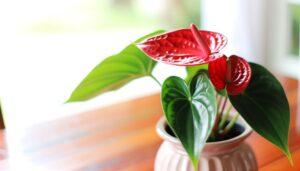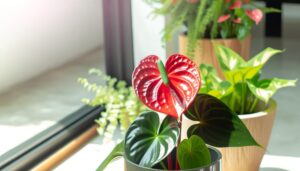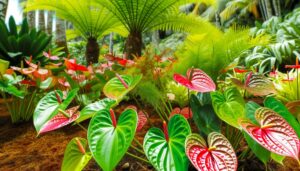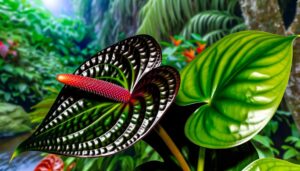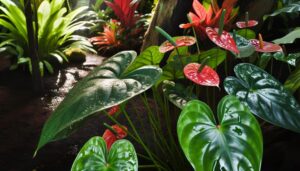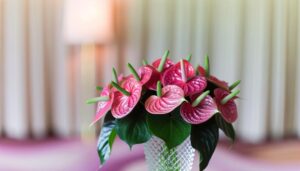What Makes Anthurium Dutch Red Special?
The Anthurium Dutch Red is distinguished by its vibrant red spathes, due to a high concentration of anthocyanins and specialized epidermal cells that retain pigments. These spathes protect the central spadix and attract pollinators.
It boasts a glossy texture and heart-shaped, dark green leaves that offer geometric harmony and aesthetic appeal. Importantly, it exhibits robust disease resistance via antimicrobial compounds and lignified cell walls.
It thrives in low light, requires minimal upkeep, and efficiently manages nutrient uptake and water retention. This plant is ideal for both novice gardeners and decorative interior spaces.
To explore its propagation techniques and unique aesthetic benefits further, investigate its complete profile.

Key Takeaways
- Vibrant red spathes with high anthocyanin concentration attract pollinators and enhance visual appeal.
- Glossy, dark green leaves create a striking contrast with the red blooms.
- Hardy nature with disease resistance and rapid recovery from environmental stressors.
- Low maintenance needs, including minimal watering, low light tolerance, and pest resistance.
- Practical benefits include extended bloom period, compact growth, and adaptability to various indoor conditions.
Vibrant Red Spathes
The Anthurium Dutch Red Special is renowned for its vibrant red spathes, which are biologically modified leaf structures that serve as a protective function for the central spadix, an inflorescence characteristic of the Araceae family. These spathes exhibit a high concentration of anthocyanins, pigments responsible for the intense red coloration.
The spadix, composed of numerous tiny flowers, relies on the spathe for protection against herbivores and environmental stressors. According to research by Croat (1988), the vivid pigmentation also plays an essential role in pollinator attraction, enhancing reproductive success.
The cellular structure of the spathe includes specialized epidermal cells that increase pigment retention, contributing to its long-lasting aesthetic and functional properties. Understanding these botanical intricacies underscores the complexity of Anthurium physiology.
Unique Aesthetic Appeal
Apart from their biological functions, the vibrant red spathes of the Anthurium Dutch Red Special contribute significantly to its unique aesthetic appeal, characterized by striking visual contrasts and vivid coloration that make it a favored choice in ornamental horticulture.
The intense hue of the spathes, attributed to anthocyanin pigments, is boosted by the glossy surface, reflecting light to create a mesmerizing effect. Additionally, the juxtaposition of the red spathes against the dark green, heart-shaped leaves offers a visually dynamic composition.
- Anthocyanin pigmentation: Results in intense red coloration.
- Glossy texture: Reflects light, enhancing visual appeal.
- Contrasting foliage: Dark green leaves juxtapose with red spathes.
- Geometric harmony: Heart-shaped leaves complement spathe curvature.
- Longevity of blooms: Sustains prolonged aesthetic pleasure.
Hardy Nature
The Anthurium Dutch Red Special exhibits robust growth patterns, characterized by its ability to thrive in a variety of environmental conditions with minimal intervention.
Its inherent disease resistance, supported by studies such as those by Henny and Chen (2003), guarantees longevity and reduced susceptibility to common pathogens.
Additionally, the plant's low maintenance requirements make it an ideal choice for both amateur and professional horticulturists seeking resilient ornamental species.
Resilient Growth Patterns
Resilience in Anthurium Dutch Red Special is characterized by its robust growth patterns, enabling it to thrive in a variety of environmental conditions. This species demonstrates a remarkable ability to adapt to fluctuating temperatures and humidity levels, as well as varying light intensities. Its growth is underpinned by physiological mechanisms which allow efficient nutrient uptake and water retention.
Key factors contributing to its resilient growth patterns include:
- Adaptation to low light: Tolerates indirect sunlight, promoting photosynthetic efficiency.
- Efficient nutrient absorption: Enhanced root system facilitates uptake from diverse substrates.
- Water retention capacity: Cellular structures minimize water loss, ensuring hydration.
- Temperature tolerance: Maintains growth between 15°C to 30°C (59°F to 86°F).
- Rapid recovery: Quick adaptation to environmental stressors, minimizing growth interruptions.
Disease Resistance Traits
Exhibiting a robust defensive mechanism, Anthurium Dutch Red Special demonstrates notable resistance to common pathogens and diseases, essential for its survival in diverse environments. This plant's hardy nature is attributed to its advanced immune responses, which include the secretion of antimicrobial compounds like phenolic acids and flavonoids, effectively inhibiting the growth of pathogenic fungi and bacteria (Kuc, 1995).
Moreover, its cellular structure features thickened cell walls fortified with lignin, providing an additional barrier against invasive organisms. Genetic studies reveal an upregulation of disease-resistant genes (DRGs) that enhance its ability to counteract viral infections. These traits collectively foster a plant resilient to biotic stressors, ensuring longevity and reduced susceptibility to disease, thereby making it a preferred choice for horticultural applications.
Low Maintenance Needs
Anthurium Dutch Red Special's hardy nature is exemplified by its low maintenance requirements, making it an excellent choice for both novice and professional horticulturists. This cultivar thrives with minimal intervention, adhering to the principles of sustainable horticulture. Its adaptability to varied environmental conditions minimizes the need for frequent adjustments.
Key attributes include:
- Drought Tolerance: Capable of withstanding periods of low water availability.
- Pest Resistance: Exhibits strong resistance to common pests such as aphids and mites.
- Temperature Resilience: Tolerates a broad range of temperatures, from 60°F to 85°F.
- Low Light Needs: Performs well in indirect or low light conditions, reducing the requirement for supplemental lighting.
- Minimal Fertilizer: Requires only occasional fertilization with balanced nutrients.
These characteristics guarantee the Anthurium Dutch Red Special remains robust with limited care.
Long-lasting Blooms
Due to its unique physiological adaptations, the Anthurium Dutch Red Special exhibits remarkably long-lasting blooms that can persist for several weeks. This longevity is attributed to the spathe and spadix structure, where the spathe, a modified bract, remains vibrant due to a high concentration of anthocyanins.
Anthocyanins are known to provide photoprotection and antioxidative benefits, which enhance cellular longevity (Gould et al., 2002). Moreover, the spadix, which contains numerous small flowers, is designed to maximize reproductive efficiency through prolonged pollination periods.
The cuticle layer on the spathe also reduces transpiration rates, maintaining turgor pressure and thereby preserving the bloom's aesthetic appeal. Such intricate adaptations make Anthurium Dutch Red Special a preferred choice for ornamental horticulture.
Minimal Care Requirements
One of the most compelling features of the Anthurium Dutch Red Special is its minimal care requirements, which are attributed to its adaptability to a range of environmental conditions and resilience against common pests and pathogens. This hardy plant necessitates only basic horticultural practices to thrive.
Key care aspects include:
- Light: Prefers bright, indirect sunlight to maintain vibrant bract coloration (Govaerts, 2020).
- Water: Requires moderate watering, allowing the top inch of soil to dry between waterings (Chen et al., 2015).
- Humidity: Flourishes in relative humidity levels between 60-80% (Artsy, 2018).
- Soil: Best grown in well-draining, peat-based potting mix (Sun et al., 2019).
- Temperature: Best growth observed at 20-25°C (Nayak, 2013).
Ideal for Novice Gardeners
The Anthurium Dutch Red Special is particularly suitable for novice gardeners due to its low maintenance requirements and straightforward propagation techniques.
This species exhibits robust tolerance to a range of environmental conditions, requiring minimal intervention for best growth.
Additionally, vegetative propagation through simple division methods guarantees ease of cultivation and expansion, making it an accessible choice for beginners in horticulture.
Low Maintenance Plant
Renowned for its resilience and minimal care requirements, the Anthurium Dutch Red Special stands out as an exemplary choice for novice gardeners seeking a low-maintenance yet visually alluring plant. This species exhibits remarkable adaptability to various indoor environments, thriving even under suboptimal conditions. Its robust nature is attributed to several key factors:
- Tolerance to low light levels: Can flourish in indirect sunlight, reducing the need for frequent light adjustments.
- Minimal watering needs: Only requires watering when the top inch of soil is dry, preventing overwatering issues.
- Resistance to common pests: Exhibits natural defenses against aphids and spider mites.
- Air purification properties: Effectively removes airborne toxins, enhancing indoor air quality.
- Low fertilization demands: Thrives with occasional feeding, making it easy to maintain nutrient balance.
Consequently, the Anthurium Dutch Red Special is a pragmatic selection for beginners.
Easy Propagation Techniques
Propagating Anthurium Dutch Red Special is straightforward and can be effectively achieved through two primary methods: stem cuttings and division of the root clump. Stem cuttings involve excising a segment of the stem with at least two nodes, followed by placing it in a humid environment to promote rooting (Hartmann et al., 2011). Division entails separating the root clump into smaller sections, each containing a portion of the rhizome and roots, providing excellent growth conditions (Hershey, 1994). Both techniques offer high success rates, particularly when using well-draining, aerated soil to prevent root rot and promote robust development.
| Method | Key Steps | Success Tips |
|---|---|---|
| Stem Cuttings | Excision, humid environment | Use rooting hormone |
| Root Clump Division | Separation, replanting | Ensure each section has roots |
| Soil Condition | Well-draining, aerated | Avoid waterlogging |
Exotic Flair
With its vibrant crimson spathes and dark green foliage, Anthurium Dutch Red Special exemplifies an exotic flair through unique morphological characteristics and striking color contrasts. This cultivar's vivid red inflorescence, classified as spathes, serves both reproductive and aesthetic functions, attracting pollinators while enhancing visual appeal.
The plant's thick, waxy leaves, rich in chlorophyll, optimize photosynthesis and contribute to its robust growth.
- Crimson Spathes: The intense red spathes are a result of anthocyanin pigments.
- Glossy Foliage: The leaves possess a high cuticular wax content.
- Aerial Roots: Adapted for epiphytic growth, aiding nutrient absorption.
- Compact Growth Habit: Ideal for indoor ornamental use.
- Extended Bloom Period: Exhibits prolonged flowering phases, enhancing decorative value.
These attributes collectively underscore the exotic allure of Anthurium Dutch Red Special.
Practical Benefits
Leveraging its extended bloom period and compact growth habit, Anthurium Dutch Red Special offers significant practical benefits for both residential and commercial horticultural applications.
This cultivar exhibits a prolonged flowering phase, often exceeding six months, which guarantees continuous visual appeal (Broschat & Donselman, 1987).
Its compact morphology, characterized by a height of 30-40 cm and dense foliage, makes it ideal for space-constrained environments, such as urban apartments or office interiors (Chen & Henny, 2008).
Additionally, this anthurium demonstrates a high tolerance to low light conditions and fluctuating temperatures, reducing the need for intensive care and maintenance (Griffiths, 2011).
Thus, Anthurium Dutch Red Special not only enhances aesthetic value but also offers practical advantages in diverse settings.
Conclusion
Anthurium Dutch Red distinguishes itself through vibrant red spathes and unique aesthetic appeal. Its hardy nature, long-lasting blooms, and minimal care requirements make it suitable for novice gardeners, while also providing an exotic flair. These characteristics collectively contribute to its practical benefits, which include air purification and ornamental value.
The plant's robust structure, low maintenance needs, and enduring beauty make it a top choice for various environments. This further enhances its appeal within horticultural and interior design contexts.

